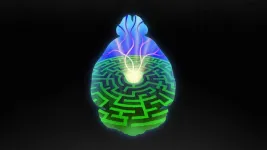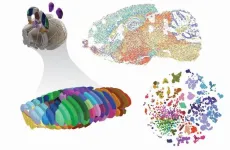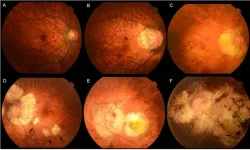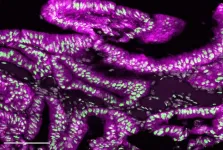(Press-News.org) Cannabis use for medicinal or recreational purposes is now permitted is most states in the U.S. Many of the products sold in dispensaries contain delta-9-tetrahydrocannabinol (better known as “THC”), and are thus classified as Schedule I drugs, making them illegal under federal law.
However, there is a parallel market for products derived from hemp—defined as cannabis containing less that 0.3 percent THC—spurred in part by the passage of the 2018 Farm Bill, which removed hemp-derived cannabinoids from the federal Controlled Substances Act.
A new U-M study published in JAMA Network Open examines past-year use of some of these hemp-derived cannabinoids, including cannabidiol (CBD), Delta 8-THC, cannabigerol (CBG), and cannabinol (CBN).
“While the de-scheduling of hemp products initially opened up the market for CBD products, it also applies to the 100-plus cannabinoids also found in the plant. That means, as with CBD, all of them can follow that same path and be sold in gas stations, as ingredients in cosmetics, as well as in dispensaries—there will likely be substantial proliferation of some of these compounds,” said Kevin Boehnke, Ph.D. of the Chronic Pain and Fatigue Research Center and the Department of Anesthesiology at the University of Michigan Medical School.
Using a census-representative sample of adults from the National Opinion Research Center (NORC) AmeriSpeak panel, Boehnke and his colleagues examined knowledge of and past-year use of the most popular hemp derived cannabinoids.
Overall, 72% participants heard of CBD, while fewer had heard of delta-8-THC (41%), CBG (18%), or CBN (17%). Similarly, 21% reported using CBD in the past year, compared with 12% for delta-8-THC, 5% for CBG, and 4% for CBN. Furthermore, people living in states without legal medical or recreational cannabis laws had higher rates of using delta-8-THC.
“Delta-8-THC purportedly has quite similar effects to delta-9-THC (better known as THC). In other words, there is a loophole where people in states without legal cannabis can get high legally on delta-8-THC. It makes sense then that people who don’t have access to regulated markets would be more likely to use it,” said Boehnke.
However, use of these alternative cannabinoids is concerning, says Boehnke, because these products are largely unregulated and have inadequate safety testing for contaminants like pesticides and solvents. Further, many may not contain the amounts listed on the label.
“Not only are people with medical conditions being sold products with uncertain therapeutic effects, but these products may contain contaminants that are harmful,” said Boehnke. He adds that without a basic framework ensuring adequate laboratory testing for safety, alternative cannabinoid products could be putting people, especially young people, at risk.
Additional authors include Adrianne R. Wilson-Poe PhD, Tristin Smith MPH, Michael R. Elliott PhD, and Daniel J. Kruger PhD.
Paper cited: “Past-year use prevalence of cannabinoids CBD, CBG, CBN, and delta-8-THC in the United States,” JAMA Network Open, http://jamanetwork.com/journals/jamanetworkopen/fullarticle/10.1001/jamanetworkopen.2023.47373?utm_source=For_The_Media&utm_medium=referral&utm_campaign=ftm_links&utm_term=121323
END
Growing use of hemp-derived alternative cannabis products containing CBD, Delta-8-THC, CBG, CBN
A lack of regulation around CBD, Delta-8 and other cannabinoids could open up consumers for harm
2023-12-13
ELSE PRESS RELEASES FROM THIS DATE:
Penn Medicine research shows how stress activates neurons that disrupt sleep
2023-12-13
PHILADELPHIA— New research reveals that neurons in the preoptic hypothalamus—the region of the brain that regulates sleep and body temperature—are rhythmically activated during non-rapid eye movement sleep (NREM). Stress activates these brain cells out of turn, causing “microarousals,” that interrupt sleep cycles and decrease the duration of sleep episodes, according to research from Perelman School of Medicine at the University of Pennsylvania, published today in Current Biology.
While our bodies are at rest when we are asleep, ...
New study sheds light on how the brain learns to seek reward
2023-12-13
By Jake Siegel
Imagine you’re teaching a dog to play fetch. You throw a ball, and your dog sprints after it, picks it up, and runs back. You then reward your panting pup with a treat. But now comes the real trick for your dog: figuring out which part of that sequence earned the treat. Scientists call this the 'credit assignment problem' in the brain. It's a fundamental question about understanding which actions are responsible for the positive outcomes we experience.
Dopamine, a key chemical ...
Salk teams assemble first full epigenomic cell atlas of the mouse brain
2023-12-13
LA JOLLA (December 14, 2023)—Salk Institute researchers, as part of a worldwide initiative to revolutionize scientists’ understanding of the brain, analyzed more than 2 million brain cells from mice to assemble the most complete atlas ever of the mouse brain. Their work, published December 14, 2023 in a special issue of Nature, not only details the thousands of cell types present in the brain but also how those cells connect and the genes and regulatory programs that are active in each cell.
The efforts were coordinated by the National Institutes of Health’s Brain Research Through Advancing Innovative Neurotechnologies® Initiative, or the BRAIN Initiative®, ...
Scientists unveil first complete cellular map of adult mouse brain
2023-12-13
By Jake Siegel
Six years and 32 million cells later, scientists have created the first full cellular map of a mammalian brain. In a set of 10 papers in Nature today, a network of researchers unveiled an atlas cataloging the location and type of every cell in the adult mouse brain. Using advanced technologies that profile individual cells, the teams identified over 5,300 cell types – far more than known before – and pinpointed their locations within the brain’s intricate geography. ...
Using next-gen CRISPR tool, Gladstone scientists create unprecedented molecular map of human immune response
2023-12-13
SAN FRANCISCO—December 13, 2023—In a study of historic scale, scientists at Gladstone Institutes have created an intricate map of how the immune system functions, examining the detailed molecular structures governing human T cells using the next-generation CRISPR tool known as base editing.
Their findings, published in Nature, uncover detailed information that could help overcome the limitations of today’s immunotherapies and identify new drug targets for a wide range of diseases, including autoimmune diseases and cancer.
Led by Gladstone Senior Investigator Alex Marson, MD, PhD, the team dove deep into the DNA of T cells, pinpointing ...
Discovery of magnetic liquid crystal
2023-12-13
Liquid crystal is a state of matter that exhibits properties of both liquid and solid. It can flow like a liquid, while its constituent molecules are aligned as in a solid. The liquid crystal is widely used nowadays, for example, as a core element of LCD devices. The magnetic analog of this kind of material is dubbed the “spin-nematic phase”, where spin moments play the role of the molecules. However, it has not yet been directly observed despite its prediction a half-century ago. The main challenge stems ...
A rare enzyme role change with bacterial defense system assembly
2023-12-13
COLUMBUS, Ohio – Scientists have revealed a never-before-seen phenomenon in a protein: Alone, the enzyme processes DNA and RNA but, when bound to another protein as part of a defense system, interacts with a completely different type of compound to help bacteria commit suicide.
The finding came about as the researchers focused on detailing how this defense mechanism works in bacteria that are infected by phages, viruses that invade and make copies of themselves inside bacterial cells. In addition to detailing the proteins’ structures and binding sites, the experiments unearthed ...
Machine learning sees into the future to prevent sight loss in humans
2023-12-13
Researchers from Tokyo Medical and Dental University (TMDU) develop models based on machine learning that predict long-term visual acuity in patients with high myopia, one of the top three causes of irreversible blindness in many regions of the world
Tokyo, Japan – Machine learning has been found to predict well the outcomes of many health conditions. Now, researchers from Japan have found a way to predict whether people with severe shortsightedness will have good or bad vision in the future.
In a study recently published in ...
Scientists unveil complete cell map of a whole mammalian brain
2023-12-13
For the first time ever, an international team of researchers has created a complete cell atlas of a whole mammalian brain. This atlas serves as a map for the mouse brain, describing the type, location, and molecular information of more than 32 million cells and providing information on connectivity between these cells. The mouse is the most commonly used vertebrate experimental model in neuroscience research, and this cellular map paves the way for a greater understanding of the human brain—arguably the most powerful computer in the world. The cell atlas also lays the foundation for the development of a new generation of precision therapeutics for people ...
Cholesterol-lowering therapy may hinder aggressive type of colorectal tumor
2023-12-13
Hard-to-detect colorectal pre-cancerous lesions known as serrated polyps, and the aggressive tumors that develop from them, depend heavily on the ramped-up production of cholesterol, according to a preclinical study from researchers at Weill Cornell Medicine. The finding points to the possibility of using cholesterol-lowering drugs to prevent or treat such tumors.
In the study, published Oct. 13 in Nature Communications, the researchers analyzed mice that develop serrated polyps and tumors, detailing the chain of molecular events in these tissues that leads to increased cholesterol production.
They ...
LAST 30 PRESS RELEASES:
Korea University researchers discover that cholesterol-lowering drug can overcome chemotherapy resistance in triple-negative breast cancer
Ushikuvirus: A newly discovered giant virus may offer clues to the origin of life
Boosting the cell’s own cleanup
Movement matters: Light activity led to better survival in diabetes, heart, kidney disease
Method developed to identify best treatment combinations for glioblastoma based on unique cellular targets
Self-guided behavioral app helps children with epilepsy sleep earlier
Higher consumption of food preservatives is associated with an increased risk of type 2 diabetes
NTU Singapore-led team captures first-ever ‘twitch’ of the eye’s night-vision cells as they detect light, paving the way for earlier detection of blindness-causing diseases
Global aviation emissions could be halved through maximising efficiency gains, new study shows
Fewer layovers, better-connected airports, more firm growth
Exposure to natural light improves metabolic health
As we age, immune cells protect the spinal cord
New expert guidance urges caution before surgery for patients with treatment-resistant constipation
Solar hydrogen can now be produced efficiently without the scarce metal platinum
Sleeping in on weekends may help boost teens’ mental health
Study: Teens use cellphones for an hour a day at school
After more than two years of war, Palestinian children are hungry, denied education and “like the living dead”
The untold story of life with Prader-Willi syndrome - according to the siblings who live it
How the parasite that ‘gave up sex’ found more hosts – and why its victory won’t last
When is it time to jump? The boiling frog problem of AI use in physics education
Twitter data reveals partisan divide in understanding why pollen season's getting worse
AI is quick but risky for updating old software
Revolutionizing biosecurity: new multi-omics framework to transform invasive species management
From ancient herb to modern medicine: new review unveils the multi-targeted healing potential of Borago officinalis
Building a global scientific community: Biological Diversity Journal announces dual recruitment of Editorial Board and Youth Editorial Board members
Microbes that break down antibiotics help protect ecosystems under drug pollution
Smart biochar that remembers pollutants offers a new way to clean water and recycle biomass
Rice genes matter more than domestication in shaping plant microbiomes
Ticking time bomb: Some farmers report as many as 70 tick encounters over a 6-month period
Turning garden and crop waste into plastics
[Press-News.org] Growing use of hemp-derived alternative cannabis products containing CBD, Delta-8-THC, CBG, CBNA lack of regulation around CBD, Delta-8 and other cannabinoids could open up consumers for harm






